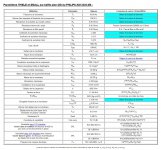Thanks GM.
You're welcome!
He wrote in detail what I summed up in a few words
Anyway, found my old Lotus 1-2-3/Excel SS that calculates this stuff, but without driver specs all I can tell you is that for a given set of Fs, Vas, Qes, Re specs, doubling Re doubles Qes, efficiency drops 3 dB [half power], so typically this is the max loss where:
Re = measured voice coil resistance
Rs = total added series resistance [wiring, XO components, amp output impedance]
Qes' = Qes*(1+Rs/Re)
n0 = 9.6352*10^-10*Fs^3*Vas/[Qes']
SPL = 112.018+10*LOG(n0)
GM
Thanks again GM.Anyway, found my old Lotus 1-2-3/Excel SS that calculates this stuff, but without driver specs all I can tell you is that for a given set of Fs, Vas, Qes, Re specs, doubling Re doubles Qes, efficiency drops 3 dB [half power], so typically this is the max loss where:
Then, roughly, we can say that you could lose 3 dB using a 15 ohms on a 8 ohm amplifier tab. It would not be a problem if is sensitive enough. But I found the full parameters developed in a French site. According to them, is not 100 dB but around 97. Paramètres haut-parleur de THIELE et SMALL, sans filtre ni ampli
This model is about parameters from the 8 ohms model, but we can approximate the Re and the nominal voltage for the 15 ohms, based on the progression of this parameter on the 4 and 8 ohms models. Increasing this voltage by raising the impedance output transformer almost doubled, is the point that concerns me, more than the loss of efficiency in terms of the general sound pressure or how loud I can hear my amp. Because if I understood well, increasing voltage and temperature in the voice coil would produce differences in the sound attributes also. In a second term, if I have 97 dB ,if I lose 3 dB, would have 94 dB. I believe is enough if the impedances didn't drop too much across the frecuency range.
I found this paper also, about the temperature on the voice coil that I'm reading now. (at the same time I'm trying to learn Ohm's law, Kirchhoff's rules, etc in an express way) http://epubl.ltu.se/1402-1617/2008/096/LTU-EX-08096-SE.pdf
Thanks you again for your very informative insights.
Regards
Attachments
Last edited:
Thank you David for the explanation. I'm gathering all the information needed to take advantage of your software.Hornresp calculates the increase in voice coil resistance due to the coil being heated above the standard reference value of 20 degrees Celsius. The value of the increased voice coil resistance due to heating is displayed in the status bar panel at the bottom of the input parameters window when the mouse pointer is moved over the Re text box
Best regards
- Status
- This old topic is closed. If you want to reopen this topic, contact a moderator using the "Report Post" button.
